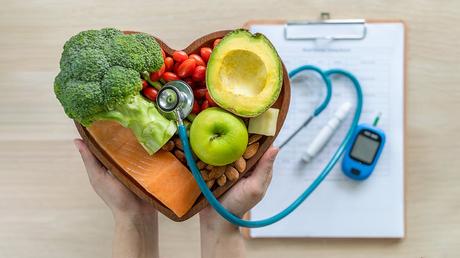Have you been told that you have prediabetes or that you're at risk for type 2 diabetes? You're not alone. Prediabetes is extremely common, affecting more than one third of all American adults. The good news is that you can control, or even reverse, this condition by making a few simple diet and lifestyle changes - no medications required.
Read on to learn about prediabetes and the steps you can take today to reverse it.

What is prediabetes?
Prediabetes is a health condition in which your blood sugar levels are above the normal range but not high enough for you to be diagnosed with diabetes.
It is one of the most common conditions in the modern world, and the number of people affected by this condition is growing steadily.
According to one study, about 88 million adults living in the US had prediabetes in 2020. Today, the CDC estimates that roughly 96 million American adults have prediabetes - about 38% of the US population, or more than 1 in 3 people. And most people with prediabetes are unaware that they have it.
By contrast, the CDC estimates that about 37 million American adults, or 1 in 7 people, have diabetes.
Where does the high blood sugar come from?
The sugar (glucose) in your blood comes from eating certain foods and from your liver. Your liver stores sugar and releases it into your bloodstream as needed.
When you eat sugar and starches, they are broken down into glucose and quickly absorbed into your blood. This causes your blood sugar to begin rising. In response, your pancreas produces insulin, a hormone that directs glucose to move from your blood into your cells. When this is working well, the sugar, or glucose, in your blood stays within a narrow range.
If you have prediabetes, in most cases, your pancreas produces insulin normally, but your cells don't fully respond to insulin's effects. This is called insulin resistance, and it causes blood sugar to increase above the healthy range. As a result, your pancreas produces even more insulin in an attempt to return high blood sugar to normal levels.
During prediabetes, your blood sugar and insulin levels may gradually increase over several years. In short, you don't go from having normal blood sugar one day to having type 2 diabetes the next. It's an evolving process. And prediabetes is the intermediate step.
In some cases, diabetes complications can start developing during the prediabetes stage - including eye, kidney, and nerve damage - years before any symptoms occur. Having prediabetes also increases your risk of heart disease.
So, it's important to take prediabetes seriously.
What are the signs of prediabetes? You probably won't have any. This may be why most people aren't aware that they have prediabetes: they don't have any concerning symptoms that prompt them to visit their doctor.
One possible subtle prediabetes symptom is darkened skin in the folds of your neck, armpits, or groin. The medical term for these patches is acanthosis nigricans. You may develop these darkened areas of skin if you have elevated insulin levels and insulin resistance.
Your doctor can diagnose you with prediabetes if you meet one or more of three criteria
- a fasting blood glucose level between 100 to 125 mg/dL (5.6 to 7.0 mmol/L)
- a hemoglobin A1c (HbA1c) of 5.7% to 6.4% (39 to 46 mmol/mol)
- a blood glucose level between 140 and 199 mg/dL (7.8 to 11 mmol/L) two hours after drinking a solution with 75 grams of glucose during an oral glucose tolerance test (OGTT)
Because they are routine blood tests, fasting blood glucose and HbA1c are the most common methods for diagnosing prediabetes. Check your most recent lab report for these values. If you don't see an HbA1c on your lab report, you may want to ask your doctor to order one.
You can also buy a blood glucose meter at any pharmacy to check your blood sugar levels at home. However, keep in mind that these meters provide less accurate results than laboratory blood tests. While a meter can help you monitor your blood sugar, you'll need a lab test for a formal prediabetes diagnosis.
1. Diet
You can take steps to reverse prediabetes in ways that fit your preferences and abilities. Let's start with the most important one: changing the way you eat. If you are overweight with too much body fat, any healthy weight loss could lower the risk of prediabetes. However, two eating patterns likely help more than others: low carb and high protein.
Cut back on carbs
Bread, potatoes, fruit, and other foods contain carbohydrates (carbs), which your body breaks down into glucose (sugar). The glucose is absorbed into your blood, which raises your blood sugar. So it shouldn't be surprising to hear that eating fewer carbs can be beneficial for lowering blood sugar.
Indeed, strong evidence shows that people with type 2 diabetes who follow a low carb diet can safely and effectively improve their blood sugar control and lose weight. Although we have much less research on carb reduction in people with prediabetes, the results so far are encouraging.
In a 2021 trial, 96 people with prediabetes followed a very low carb diet for two years. At the end of the trial, more than 50% of the participants had lowered their blood sugar to normal levels. Additionally, they lost an average of 26 pounds (12 kilos) and reduced their fasting insulin levels.
Although this wasn't a randomized trial with a control group, it shows that people with prediabetes can completely reverse their condition by eating very few carbs. Also important: an impressive 75% of participants completed the two-year trial, demonstrating that this way of eating is sustainable long term.
In a 12-month randomized trial, people with prediabetes who ate a very low carb diet lowered their blood sugar and lost more weight than those who ate a moderate carb diet. Another 12-month randomized trial found that significantly more people who ate a low carb diet achieved normal blood sugar levels compared to those who followed a higher carb diet.
Importantly, not everyone with prediabetes is overweight. Following a very low carb diet can improve your blood sugar levels even if you don't need to lose weight.
How low carb do you need to go to reverse prediabetes? In the studies above, people consumed between 30 grams to 50 grams of total carbs (about 20 to 30 grams of net carbs) per day. However, you may be able to keep your blood sugar within a healthy range by eating slightly more carbs.
You can determine your personal carb tolerance by testing your blood sugar 1 to 2 hours after eating to make sure you stay below 140 mg/dL (7.8 mmol/L).
A prediabetes diet can include these low carb foods:
- protein: meat, poultry, seafood, eggs, Greek yogurt, cheese, tofu, and edamame
- non-starchy vegetables: greens, asparagus, cauliflower, broccoli, avocados, cucumbers, and many more
- smaller amounts of berries, nuts, seeds, butter, and oil
Low carb meal planning for prediabetes
How can you put together a nutritious, satisfying meal that will keep your blood sugar within the normal, healthy range? Just follow these four easy steps:
- Start with a generous serving of protein. Aim for at least 4 ounces (113 grams) - a piece of meat, seafood, or tofu slightly larger than the size of a deck of cards.
- Include as many non-starchy vegetables as you want.
- Use about a tablespoon or two of fat (such as butter or olive oil) for cooking, in salad dressing, or to add to your food at the table.
- Season with salt and spices. Adding salt can be especially helpful for relieving symptoms of the keto flu that often occur when starting a very low carb diet.
Getting plenty of protein is important. Why? For starters, protein provides essential amino acids that your body requires to build and maintain muscle. In addition, eating a high protein diet can help you feel full and satisfied, slightly boost your metabolism, and improve your body composition.
Plus, consuming more protein may help reverse prediabetes.
In a small trial, 100% of people with prediabetes who ate a high protein, moderate carb diet for six months achieved normal blood sugar levels. Importantly, the studies discussed earlier that reported prediabetes reversal with a very low carb diet were also higher in protein than the comparison diet.
2. Additional dietary strategies to reverse prediabetes
Weight loss
While a keto or low carb diet is likely the most effective way to reverse prediabetes, people who are carrying excess weight can improve their prediabetes by losing weight with either low carb or other dietary approaches that provide adequate protein.
Plus, if you lose weight in a healthy way - by losing body fat while maintaining your muscle - you'll be even more likely to achieve healthy blood sugar levels and prevent type 2 diabetes. You can learn more about healthy weight loss in our complete guide.
Avoid high carb foods
To reverse prediabetes, avoid pasta, rice, bread, potatoes, and most high-sugar fruit other than berries. These foods can raise blood sugar due to their high carb content.
Stay far away from ultra-processed foods that are high in both carbs and fat, such as candy bars, doughnuts, chips, and similar products. In addition to raising blood sugar, eating these products can promote weight gain. Some researchers suggest that these foods may even be addictive.
Finally, don't drink your calories. Sugary beverages like soda, sweetened coffee and tea, and fruit juice can rapidly raise blood sugar. And even low carb alcoholic drinks can increase your appetite and decrease your inhibitions, which may lead you to overeat without even realizing it. So go easy with alcohol and avoid sweetened beverages altogether.
3. Exercise
Although changing your diet is the most important step for reversing prediabetes, several types of physical activity can also be helpful:

Aerobic or cardiovascular (cardio) exercise
As you may have heard, doing an activity that raises your heart rate - such as running, cycling, or dancing - can help you lose body fat. In studies, engaging in aerobic exercise several times a week has also been shown to improve blood sugar response in people with prediabetes, even when performed at moderate intensity, such as brisk walking.

High-intensity interval training
Rapid bursts of strenuous exercise alternating with periods of lower-intensity movement is known as high-intensity interval training (HIIT). Research suggests it may help you burn more calories than other forms of exercise performed for the same duration.
And studies demonstrate that it can help lower blood sugar, improve insulin resistance, and burn body fat in those with prediabetes or obesity.

Resistance training
Strength training (lifting weights or pushing or lifting your own body weight, such as doing push-ups or chin-ups) can help you build muscle and burn more calories at rest. Researchers report that, like other forms of exercise, resistance training can help people with prediabetes improve their blood sugar levels and reduce their risk of developing type 2 diabetes.
Some theorize that building muscle via resistance training may play a role in reducing blood sugar because the incremental muscle mass acts as a "sink" that takes up glucose more easily.
So, which type of exercise should you do? Since many different kinds of exercise can help improve prediabetes, it's best to choose activities you enjoy and can do several times a week consistently.
But remember, changing how you eat is essential for conquering prediabetes. Eating a diet high in fast-digesting carbs has been shown to interfere with the blood sugar benefits of exercise.
Learn more about different types of exercise and how to get started in our complete exercise guide.
4. Other lifestyle changes
Besides changing the way you eat and exercise, you can take additional steps to improve prediabetes, such as:Getting enough sleep
Do you get plenty of high-quality sleep on a regular basis? Lack of sleep has been shown to increase blood sugar levels and insulin resistance. Research suggests that people with prediabetes who don't get enough sleep may be more likely to progress to type 2 diabetes.
How many hours of sleep do you need? Many experts suggest we need at least seven hours of sleep, but this seems to vary from person to person and may change with age and other factors. What's important is getting the amount of restorative sleep that's right for you, so you can feel and perform your best.
To improve your sleep, get up and go to bed around the same times every day, don't drink caffeinated beverages after lunch, and avoid cell phones and other screens before bedtime.
Managing stress
While having some stress is a normal part of life, feeling overly stressed for extended periods of time can play havoc with your health. For one thing, chronic stress may worsen insulin resistance.
Although you may not be able to get rid of stress, you can reduce or manage it. Engaging in meditation and mindful practices may help. Other activities that help you relax - such as walking, dancing, or talking with a friend - may also be beneficial.
What are the risk factors for prediabetes?
According to the CDC, several factors can increase your risk of prediabetes, including:
- having a BMI of 25 or more, especially if you carry excess weight around the middle and have other features of metabolic syndrome, such as elevated blood pressure
- being 45 years or older
- having a family history of type 2 diabetes, especially if you do not have obesity
- living a sedentary lifestyle
- having a history of gestational diabetes
- being of African, Indian, Hispanic, Pacific Islander, or Native American ethnicity
Women with polycystic ovary syndrome (PCOS) are also at increased risk of prediabetes.
Although meeting one or more of these criteria doesn't mean that you will definitely get prediabetes, it increases your risk of developing it. So if you fall into any of these categories, you may want to get tested for prediabetes and start making lifestyle changes now to prevent developing prediabetes in the future.
Does having prediabetes mean I will get type 2 diabetes?
Based on the most recent research, more than half of all people with prediabetes are expected to develop diabetes at some point in their lifetime, while others will never progress beyond prediabetes.
In some studies, people with a fasting blood sugar level or A1c at the upper end of the prediabetes range were more likely to eventually develop type 2 diabetes than those whose levels were closer to the normal range.
But no matter where your blood sugar levels are now, you can control or even reverse prediabetes by changing how you eat and adopting other healthy lifestyle habits.
You have the power to achieve normal, healthy blood sugar and prevent type 2 diabetes - by taking control of your health. Start today!
What is prediabetes and how can you reverse it? - the evidence
This guide is written by Franziska Spritzler, RD and was last updated on May 19, 2022. It was medically reviewed by Dr. Bret Scher, MD on May 17, 2022.
The guide contains scientific references. You can find these in the notes throughout the text, and click the links to read the peer-reviewed scientific papers. When appropriate we include a grading of the strength of the evidence, with a link to our policy on this. Our evidence-based guides are updated at least once per year to reflect and reference the latest science on the topic.
All our evidence-based health guides are written or reviewed by medical doctors who are experts on the topic. To stay unbiased we show no ads, sell no physical products, and take no money from the industry. We're fully funded by the people, via an optional membership. Most information at Diet Doctor is free forever.
Read more about our policies and work with evidence-based guides, nutritional controversies, our editorial team, and our medical review board.
Should you find any inaccuracy in this guide, please email [email protected].

